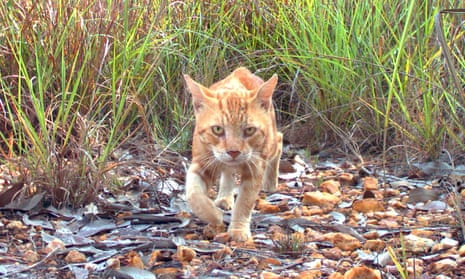Feral cats cover 99.8% of Australia at a density of one cat for every four square kilometres, according to new research.
The research was published in the journal of Biological Conservation and brings together data from almost 100 surveys completed by 40 environmental scientists from different institutions.
It found that the total number of feral cats was much lower than the 20 million previously estimated, fluctuating between 2.1 million and 6.3 million, but while that was a surprising finding, according to Dr Sarah Legge from the University of Queensland, it was not particularly reassuring.
“It just underlines how potent cats are for Australian wildlife because it really doesn’t take many cats to have a significant negative effect,” Legge told Guardian Australia.
The cat-free areas are limited to a few islands, of which 12 had feral cat populations until they were eradicated, and 16 fenced-in cat-free reserves on the mainland.
Legge said the research provided a starting point for agencies responsible for managing cat populations and would enable better planning for baiting, trapping, shooting or other eradication programs.
The former environment minister Greg Hunt in 2015 announced a plan to kill 2 million feral cats, invoking the ire of Brigitte Bardot and Morrissey and prompting the Australian government writing to both of the prominent vegans to explain its policy.
Feral cats are presumed to be responsible for the extinction of about 20 native Australian species and for putting many more on the threatened species list. They are particularly damaging to populations of critical weight range marsupials – meaning any animal that is less than 3kg.
The threatened species commissioner, Gregory Andrews, said the research “reaffirms the importance of ambitious targets to cull feral cats”.
“This new science shows that the density of feral cats in Australia is lower than it is in North America and Europe, and yet feral cats have been devastating for our wildlife,” he said.
“Australia is the only continent on Earth other than Antarctica where the animals evolved without cats, which is a reason our wildlife is so vulnerable to them. This reinforces the need to cull feral cats humanely and effectively.”
Among the proposals being suggested by conservationists are rebuilding dense habitat, so small marsupials have “boltholes” to escape cats, and increasing the dingo population in outback areas.
“A lot of work has shown that when you increase the number of dingoes, cat numbers are reduced,” Dr Christopher Dickman, from the University of Sydney, said.
Dickman, an enthusiastic supporter of “the dingo plan”, said dingoes preferred larger prey, such as kangaroos, emus or feral goats, and would be less likely to predate on the smaller marsupials now under threat of extinction from feral cats.
The problem of protecting sheep flocks – the main reason for the baiting and killing of the dingo population, Dickman said – could be solved by introducing “well-trained maremmas”, a breed of herd guardian dogs.
Alternative methods have been suggested because feral cats are difficult to trap and kill. They do not readily take baits because they prefer their food to be moving, although a Western Australian trial has had some success, and they will not walk into cage traps. Their relatively low density of one cat every 4km sq makes hunting difficult.
Suggestions that feral cats could be trapped, desexed, and rereleased as a method of population control were “crazy”, Dickman said, because you would have to desex at least 75% of the population to have an impact. That’s almost 5 million difficult-to-trap cats. Desexing cats also extends their life expectancy, so the released cats would hunt for longer.
Cats were introduced to Australia with the first fleet, where they had been kept as ratters on convict ships. They were also imported by some settlers to help control the native rat and mice population.
On one farm near Bourke, in outback New South Wales, Dickman said, settlers ordered hundreds of cats from England and then released them in an attempt to control mice numbers.
On St Francis Island, off the South Australian coast, settlers imported cats to control the brush-tailed bettongs that were eating vegetables from the gardens. The cats completely eradicated the bettongs, Dickman said.
Their efficiency, at both hunting and breeding, makes them difficult to control. “A cat might kill 10 mice to satisfy its hunger and keep itself going through the night, but if it comes across another 50 it will kill them anyway just for the hell of it,” he said.

Comments (…)
Sign in or create your Guardian account to join the discussion